|
|
Samuel Barber (Composer, Arranger) |
|
Born: March 9, 1910 - West Chester, Pennsylvania, USA
Died: January 23, 1981- New York City, New York, USA |
|
Samuel Osborne Barber II was an American composer of orchestral, opera, choral, and piano music. His Adagio for Strings is his most popular composition and widely considered a masterpiece of modern classical music. He was twice awarded the Pulitzer Prize for music, for his opera Vanessa and his Concerto for Piano and Orchestra. His Knoxville: Summer of 1915, a work for soprano and orchestra, was an acclaimed setting of prose by James Agee. |
|
Biography |
|
Samuel Barber was the son of Marguerite McLeod (née Beatty) and Samuel LeRoy Barber. Barber was born into a comfortable, educated, social, and distinguished Irish-American family. His father was a doctor, and his mother was a pianist. His aunt, Louise Homer, was a leading contralto at the Metropolitan Opera and his uncle, Sidney Homer, was a composer of American art songs. Louise Homer is noted to have influenced Barber's interest in voice. Through his aunt, Barber had access to many great singers and songs.
At a very early age, Barber became profoundly interested in music, and it was apparent that he had great musical talent and ability. He wrote his first musical at the early age of 7 and attempted to write his first opera at the age of 10. He was an organist at the age of 12. When he was 14, he entered the Curtis Institute in Philadelphia, where he studied piano, composition, and voice. Barber began composing seriously in his late teenage years. Around the same time, he met fellow Curtis schoolmate Gian Carlo Menotti, who became his partner in life as well as in their shared profession. At the Curtis Institute, Barber was a triple prodigy in composition, voice, and piano. He soon became a favorite of the conservatory's founder, Mary Louise Curtis Bok. It was through Mrs. Bok that Barber was introduced to his lifelong publisher, the Schirmer family. At the age of 18, Barber won the Joseph H. Bearns Prize from Columbia University for his Violin Sonata (now lost or destroyed by the composer).
From his early to late twenties, Samuel Barber wrote a flurry of successful compositions, launching him into the spotlight of the classical music world. Many of his compositions were commissioned or first performed by such famous artists as Vladimir Horowitz, Eleanor Steber, Raya Garbousova, John Browning, Leontyne Price, Pierre Bernac, Francis Poulenc, and Dietrich Fischer-Dieskau. When Barber was 28, his Adagio for Strings was performed by the NBC Symphony Orchestra under the direction of Arturo Toscanini in 1938, along with his first Essay for Orchestra. The Adagio had been arranged from the slow movement of Barber's String Quartet, Op. 11. Arturo Toscanini had only rarely performed music by American composers before (an exception was Howard Hanson's Second Symphony, which he conducted in 1933). At the end of the first rehearsal of the piece, Arturo Toscanini remarked: " Semplice e bella " (simple and beautiful).
Samuel Barber served in the Army Air Corps in World War II, where he was commissioned to write his Second Symphony, a work he later suppressed. Composed in 1943, the symphony was originally titled Symphony Dedicated to the Air Forces and was premiered in early 1944 by Serge Koussevitzky and the Boston Symphony Orchestra. Barber revised the symphony in 1947, then destroyed the score in 1964. It was reconstructed from the instrumental parts.
Samuel Barber spent many years in isolation (eventually diagnosed with clinical depression) after the harsh rejection of his third opera Antony and Cleopatra (which he believed contained some of his best music. "This was supposed to have been my opera!" he said). The opera was written for and premiered at the opening of the new Metropolitan Opera House on September 16, 1966. After this setback, Barber continued to write music until he was almost 70 years old. Barber's music in his later years would be lauded as reflective and contemplative, but without the morbidity or unhappiness of other composers who knew they had a limited time to live. The Third Essay for Orchestra (1978) was his last major work, and critics received it as having all the vigor and imagination of his earlier works. He died of cancer in 1981 in New York City at the age of 70. He was buried in Oaklands Cemetery in his hometown of West Chester, Pennsylvania.
Samuel Barber won the Pulitzer Prize twice: in 1958 for his first opera Vanessa, and in 1963 for his Concerto for Piano and Orchestra. He was the recipient of numerous other awards and prizes including the Rome Prize (the American version of the Prix de Rome), and election to the American Academy of Arts and Letters.
In addition to composing, Samuel Barber was active in organizations that sought to help musicians and music. He was president of the International Music Council of UNESCO, where he did much to bring into focus and ameliorate the conditions of international musical problems. He was also one of the first American composers to visit Russia (which was then a constituent republic of the Soviet Union). Barber was also influential in the successful campaign of composers against ASCAP, helping composers increase the share of royalties they receive from their compositions. |
|
Music |
|
Samuel Barber played and studied the music of J.S. Bach. He also was an adherent of Johannes Brahms, from whom he learned how to compress profound emotions into small modules of highly charged musical expression (Cello Sonata, 1932).
In 1933, after reading the poem Prometheus Unbound by Percy Bysshe Shelley, Barber composed the tone poem Music for a Scene from Shelley, Op. 7. In 1935, the work was premiered at Carnegie Hall. It was the first time the composer heard one of his orchestral works performed publicly.
Barber's compositional style has been appraised for its musical logic, sense of architectural design, effortless melodic gift, and direct emotional appeal. This was evident in the Overture to The School for Scandal (1931) and Music for a Scene from Shelley (1933). These were characteristics of his music throughout his lifetime.
Through the success of his Overture to The School for Scandal (1931), Music for a Scene from Shelley (1933), Adagio for Strings (1938); (First) Symphony in One Movement (1936), (First) Essay for Orchestra (1937) and Violin Concerto (1939), Barber garnered performances by the world's leading conductors - Eugene Ormandy, Dimitri Mitropoulos, Bruno Walter, Charles Munch, George Szell, Artur Rodziński, Leopold Stokowski, and Thomas Schippers.
His compositions later included polytonality (Second Symphony, 1944); atonality (Medea, 1946, Prayers of Kierkegaard, 1954); Twelve-tone technique (Nocturne, 1959 and the Piano Sonata, 1949); and jazz (Excursions, 1944; and A Hand of Bridge, 1959). Although not pathbreaking, Barber's compositions distill an eclectic blend of the "musical currents hovering about in his time". John Corigliano succinctly described Barber's style as "an interesting dichotomy of harmonic procedures - an alternation between post-Straussian chromaticism and often diatonic typical Amesimplicity."
Among his finest works are his four concertos, one each for Violin (1939), Cello (1945) and Piano (1962), and also the neoclassical Capricorn Concerto for flute, oboe, trumpet and string orchestra. All of these works are rewarding for the soloists and public alike, as all contain both highly virtuosic and beautiful writing, often simultaneously. The latter three have been unfairly neglected until recent years, when there has been a reawakening of interest in the expressive possibilities of these masterpieces.
Barber's final opus was the Canzonetta for oboe and string orchestra (1979/1981). Barber once said he, "liked to give his best themes to the oboe," and originally, the Canzonetta was meant to be the central movement of a three movement oboe concerto commissioned by the New York Philharmonic Orchestra. He began composing the piece in 1978 and finished it in 1979, composing nothing else afterward. Charles Turner, one of Barber's students, who completed the orchestration of the work, remarked, "in it, we find the form of Sam's life imitating that of his art by making a simple final statement and farewell."
Samuel Barber was said to compose piano music with "an extremely natural feeling" for the instrument (in pianist Vladimir Horowitz's opinion, he was the only American composer to do so). The four-piano "bagatelles" Excursions, Op. 20, (1942-1944), was his first and only venture into Americana music. Its elements of boogie-woogie, blues, theme and variations on a cowboy song, and hoedown are not typical of Barber's generally more classical style. In 1949, Barber wrote his keyboard masterpiece Piano Sonata, which has maintained a prominent position in the repertoire since its premiere. The Nocturne for Piano (Homage to John Field), Op. 33, is another respected piece which he composed for the instrument.
Barber's life partner Gian Carlo Menotti, whom he had met at Curtis, supplied the libretto for Barber's opera, Vanessa. Using his vocal training, in 1956 Barber played and sang the score to the Metropolitan Opera's General Manager, Rudolf Bing, who accepted the work. It premiered in January 1958. The title role was written for Sena Jurinac but she cancelled six weeks before the opening, to be replaced by Eleanor Steber, with whom the role has become closely identified. Vanessa won the 1958 Pulitzer Prize and gained acclaim as the first American grand opera.
Menotti also contributed the libretto for Barber's chamber opera A Hand of Bridge. Barber's Antony and Cleopatra was commissioned to open the new Metropolitan Opera House at Lincoln Center in 1966. The elaborate production designed by Franco Zeffirelli was plagued with technological disasters; it also overwhelmed and obscured Barber's music, which most critics derided as uncharacteristically weak and unoriginal. The critical rejection of music that Barber considered to be among his best sent him into a deep depression. In recent years, a revised version of Antony and Cleopatra, for which Menotti provided collaborative assistance, has enjoyed some success.
Barber's background, deeply rooted in singing (including studies with Emilio de Gogorza), his love of poetry, and his intimate knowledge and appreciation of the human voice, inspired his vocal writing. Barber's most famous vocal compositions, Knoxville: Summer of 1915 (to words by James Agee) and Dover Beach (to words from a Victorian poem by Matthew Arnold), were greatly successful. Their critical acclaim has made a powerful case for Barber as one of the 20th century's most accomplished composers for the voice.
In honor of Barber's influence on American music, on October 19, 1974 he was awarded the prestigious University of Pennsylvania Glee Club Award of Merit. This award was established in 1964 "to bring a declaration of appreciation to an individual each year who has made a significant contribution to the world of music and helped to create a climate in which our talents may find valid expression."
In September 1992, soprano Cheryl Studer, baritone Thomas Hampson, the preeminent Samuel Barber pianist John Browning and the Emerson String Quartet recorded the complete songs of Samuel Barber (with the exception of Knoxville: Summer of 1915) at the Brahms-Saal of the famous Musikverein in Vienna, Austria. The Deutsche Grammophon set has become a classic of American song on record. |
|
Notable compositions |
|
For a full list of works, see: List of compositions by Samuel Barber (Wikipedia) |
|
Dover Beach (Baritone and String Quartet), Op. 3 (1931)
The School for Scandal (Overture), Op. 5 (1931)
Cello Sonata, Op. 6 (1932)
Music for a Scene from Shelley, Op. 7 (1933)
(First) Symphony in One Movement, Op. 9 (1936)
Essay for Orchestra, Op. 12 (1937)
Adagio for Strings (arr. of String Quartet, movít 2), Op. 11 (1938)
Violin Concerto, Op. 14 (1939)
Second Essay for Orchestra, Op. 17 (1942)
Excursions, Op. 20 (1942-1944)
Capricorn Concerto, Op. 21 (1944)
Cello Concerto, Op. 22 (1945)
Medea (Ballet), Op. 23 (1946)
Knoxville: Summer of 1915 (Soprano & Orchestra), Op. 24 (1948)
Sonata for Piano, Op. 26 (1949)
Hermit Songs, Op. 29 (1953)
Prayers of Kierkegaard (Soprano, Choir & Orchestra), Op. 30 (1954)
Summer Music for Wind Quintet, Op. 31 (1956)
Vanessa (Opera), Op. 32 (1957)
A Hand of Bridge (Chamber opera), Op. 35 (1959)
Toccata Festiva (Organ and Orchestra), Op. 36 (1960)
Piano Concerto, Op. 38 (1962) |
|



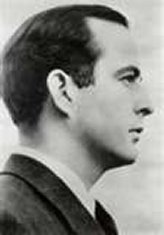
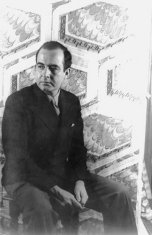
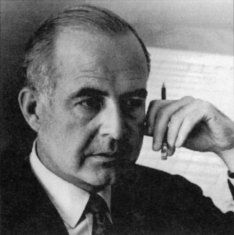
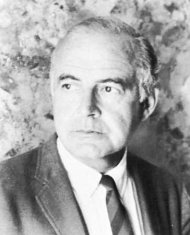
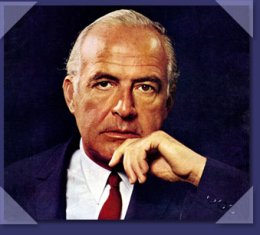
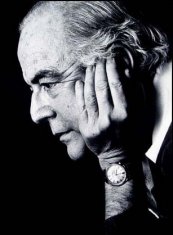

|
|
Sources:
Mostly Wikipedia Website (July 2010)
Contributed by Aryeh Oron (July 2010) |
|
Samuel Barber : Short Biography | Arrangements/Transcriptions: Works | Recordings |
|
Links to other Sites |
|
Samuel Barber (Wikipedia)
Samuel Barber Biography - Discography, Music, Lyrics, Album, CD, Career, Famous Works, and Awards (Musiciam Guide)
Samuel Barber (Find a Grave)
Samuel Barber by Paul Wittke (G. Schirmer)
Samuel Osborne Barber (PBS)
Samuel Barber by Patricia Juliana Smith (GLBTQ)
Samuel Barber - Biografie (IRCAM) [French] |
|
Bibliography |
|
Barbara B. Heyman : Samuel Barber , The Composer and his Music (New York: Oxford University Press, 1992)
John Warrack & Ewan West: The Oxford Dictionary of Opera (1992)
Walter Simmons: Voices in the Wilderness: Six American Neo-Romantic Composers (Scarecrow Press, 2006)
Jens Staubrand: Kierkegaard International Bibliography Music Works and Plays (Copenhagen 2009) |
|
|